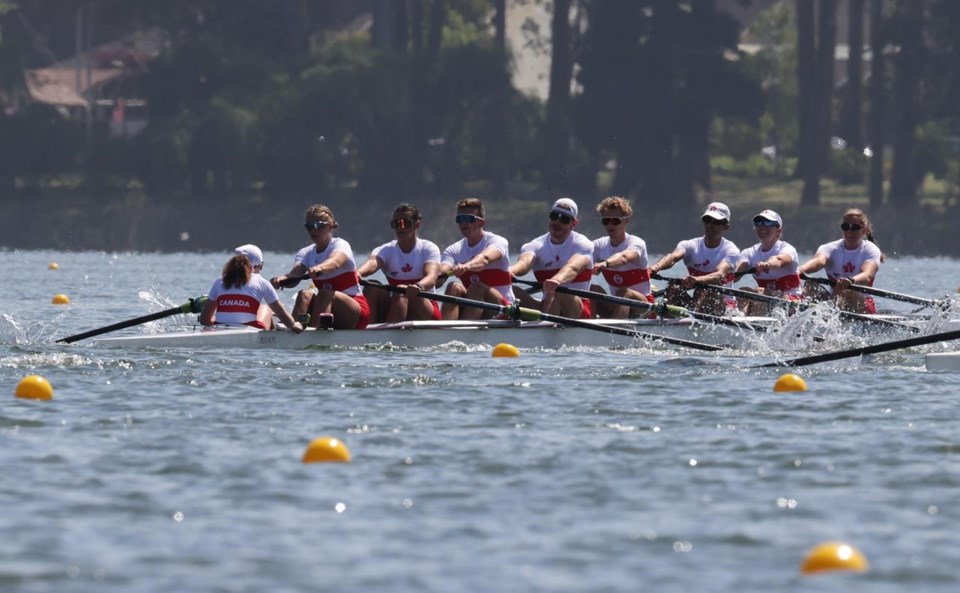SANTIAGO, Chile — Novelty has entered the rather staid sport of rowing at the Pan American Games with men and women racing together in a mixed-gender eight.
"It's so much fun to get the guys and girls together," said Canadian coxswain Kristen Kit. "We're never in a boat with the opposite gender."
Canada will race the mixed eights final Wednesday at the Laguna Grande in San Pedro de la Paz, which is 500 kilometres southwest of Chile's host city Santiago.
Kit of St. Catharines, Ont., coxed the Canadian women's eight to an Olympic gold medal in Tokyo two years ago.
But Santiago was a package of firsts for the 35-year-old who made her Pan Am Games debut coxing the women's eight to gold Tuesday and also stepping into Canada's mixed boat of four men and four women.
The mixed crew finished third in their heat and second in the repechage to advance to Wednesday's six-country final that will cap the Pan Am Games regatta.
"This is the first time I've raced mixed eights internationally," Kit said. "This is the first time the event has existed at the Pan Am Games and it is not an Olympic event."
Given the International Olympic Committee's willingness to introduce mixed gender events — mixed team triathlon made its Olympic debut in Tokyo — the Canadian cox feels Olympic inclusion is in the realm of possibilities.
"If we're ever able to see this at an Olympic Games, we'd see huge variability in who is really killing in the mixed eight," she said. "It's something I would stick around for or come back for because it's so cool."
When Kit coxed a mixed four in para rowing, she thought men and women racing the together in the eights would be intriguing.
"We were kind of surprised when we saw it was included in the Pan American Games," she said. "Right away when I saw it was included I thought 'oh my gosh, I've got to put my hand up and put my name forward for selection' because it's so neat and something I wanted to be a part of."
The mixed eights is a sweep oar race just like men's and women's crews. How to configure the men and women with their different power outputs in the longest rowing shell is still in the experimental stage, Kit said.
"To equate it to cycling, the men can turn just a bigger gear than the women because they have testosterone, which is awesome and makes you pretty strong, and women have less of it," she said.
One school of thought is slotting men in the engine room — seats three, four, five and six — and the women in the bow and the stern.
When Kit's stroke pair Abby Dent and Leia Till looked across other countries' boats in Sunday's repechage, they were the only women in seats seven and eight.
"We're kind of becoming the pseudo-pioneers of how to race a mixed eight internationally," Kit said.
Men and women have to alter their strokes for each other, she added.
"The women have to adjust because the guys are so strong, the boat's moving faster, so when they put their oar in the water, it's a different connection. It's a totally different feeling than when there's eight women in the boat," she explained. "For the guys, the boat's moving a little bit slower and so again, the connection is going to be different.
"They have to be a little bit more patient on the drive because if they just slam their legs down, they're going to lose the connection."
Any change-up to the monotony of rowing training is welcomed by the athletes and the sport could use some buzz, Kit said.
"Rowing is kind of like swimming. We're a very technical sport. We do the same thing over and over again," she said. "When you get to the Olympics, it's all about taking 234 of the same strokes with as much power as you can.
"We're not the cool guys of the sport world. We're not like the mountain bikers or the sport climbers. A mixed eight would spice it up for me."
This report by The Canadian Press was first published Oct. 24, 2023.
Donna Spencer, The Canadian Press



